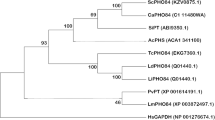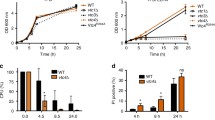Abstract
Ionic regulation in the induction of exflagellation ofPlasmodium berghei was investigated by culturing the parasites in various isotonic media. Of the salts tested, NaHCO3 exhibited the highest activity in inducing exflagellation, whereas KHCO3 showed no activity. In the absence of HCO −3 , media containing monovalent cation (Na+, K+, Cs+, Rd+, choline+, lysine+, arginine+) and Cl− also induced exflagellation, but their activities were lower than that of NaHCO3. Anions of Br− or NO −3 could be substituted with Cl−, whereas other anions such as I−, NO −2 , SO 2−4 , SCN−, H2PO −4 , or HPO 2−4 failed to induce exflagellation, as did tetramethylammonium-Cl, CaCl2, MgSO4, MgCl2 and sucrose as well. These results suggest that the induction of exflagellation requires the presence of Na+ and HCO −3 or monovalent, membrane-permeable cation and Cl− in the medium. Measurements of the efflux of H[14C]O −3 or Cl− indicated that these anions were released from the cells into the NaCl or the NaHCO3 medium, respectively, probably by exchange in HCO −3 /Cl−. Determination of intracellular ionic concentrations by electron microscopic X-ray microanalysis of cryopreserved specimens revealed that in the NaHCO3 medium, external Na+ (and probably HCO −3 ) enters the gametocytes by exchange with internal Cl− (and probably H+), whereas in Cl−-containing media, external unspecified cation and Cl− influx by exchange, probably with H+ and HCO −3 . It is therefore suggested that two separate ion exchangers, i.e., Na+-dependent HCO −3 (in)/Cl−(out) and nonspecific monovalent-cation-dependent Cl−(in)/HCO −3 (out) exchangers, are involved in the induction of gametogenesis inP. berghei. Furthermore, the presence of both classes of anion in the medium enhanced exflagellation activity and increased Na+ uptake more than did the NaCl or NaHCO3 medium alone. The apparent synergistic enhancement by two contraactive anion exchangers is consistent with a “recycling” model of pHi regulation, in which HCO −3 and Cl− are exchanged between the cells and the media, resulting in the acceleration of monovalent cation/H+ exchange.
Similar content being viewed by others
References
Askari A (1966) Uptake of some quaternary ammonium ions by human erythrocytes. J Gen Physiol 49:1147–1160
Bishop A, McConnachie EW (1960) Further observations on the in vivo development of the gametogenesis ofPlasmodium gallinaceum. Parasitology 50:431–448
Boron WF (1983) Transport of H+ and of ionic weak acids and bases. J Membr Biol 72:1–16
Boron WF, Boulpaep EL (1983) Intracellular pH regulation in the renal proximal tubule of the salamander. J Gen Physiol 81:53–94
Cala PM (1980) Volume regulation byAmphiuma red blood cells, the membrane potential and its implications regarding the nature of the ion-flux pathways. J Gen Physiol 76:683–708
Carter R, Nijhout MM (1977) Control of gamete formation (exflagellation) in malaria parasites. Science 195:407–409
Divo AA, Geary TG, Jensen JB, Ginsburg H (1985) The mitochondrion ofPlasmodium falciparum visualized by rhodamine 123 fluorescence. J Protozool 32:442–446
Doppler W, Hofmann J, Maly K, Grunicke H (1987) Amiloride and 5-N,N-dimethyl-amiloride inhibit the carrier-mediated uptake of choline in Ehrlich ascites tumor cells. Biochem Pharmacol 36:1645–1649
Frelin C, Vigne P, Ladoux A, Lazdunski M (1988) The regulation of the intracellular pH in cells from vertebrates. Eur J Biochem 174:3–14
Ganz MB, Boyarsky G, Sterzel RB, Boron WF (1989) Arginine vasopressin enhances pHi regulation in the presence of HCO −3 by stimulating three acid-base transport systems. Nature 337:648–651
Grinstein S, Garcia-Sato J, Mason MJ (1988) Differential role of cation and anion exchange in lymphocyte pH regulation. In: Bock G, Marsh J (eds) Proton passage across cell membranes. John Wiley & Sons, Chichester, pp 70–86
Jennings ML (1985) Kinetics and mechanism of anion transport in red blood cells. Annu Rev Physiol 47:519–533
Kato M, Tanabe K, Miki A, Ichimori K, Waki S (1990) Membrane potential ofPlasmodium falciparum gametocytes monitored with rhodamine 123. FEMS Microbiol Lett 69:283–288
Kawamoto F, Alejo-Blanco R, Fleck SL, Kawamoto Y, Sinden RE (1990) Possible roles of Ca2+ and cGMP as mediators of the exflagellation ofPlasmodium berghei andPlasmodium falciparum. Mol Biochem Parasitol 42:101–108
Kawamoto F, Alejo-Blanco R, Fleck SL, Sinden RE (1991)Plasmodium berghei: ionic regulation and the induction of gametogenesis. Exp Parasitol 72:33–42
LaManna JC (1987) Intracellular pH determination by absorption spectrophotometry of neutral red. Metab Brain Dis 2:167–182
Lowe AG, Lambert A (1983) Chloride-bicarbonate exchange and related transport processes. Biochim Biophys Acta 694:353–374
Madshus IH (1988) Regulation of intracellular pH in eukaryotic cells. Biochem J 250:1–8
Martin K (1966) Concentrative accumulation of choline by human crythrocytes. J Gen Physiol 51:497–516
Mikkelsen RB, Tanabe K, Wallach FH (1982) Membrane potential ofPlasmodium-infected erythrocytes. J Cell Biol 93:685–689
Moolenaar WH (1986) Effects of growth factors on intracellular pH regulation. Annu Rev Physiol 48:363–376
Nijhout MM (1979)Plasmodium gallinaceum: exflagellation stimulated by a mosquito factor. Exp Parasitol 48:75–80
Perona R, Serrano R (1988) Increased pH and tumorigenicity of fibroblasts expressing a yeast proton pump. Nature 334:438–440
Schlue WR, Deitmer JW (1988) Ionic mechanisms of intracellular pH regulation in the nervous system. In: Bock G, Marsh J (eds) Proton passage across cell membranes. John Wiley & Sons, Chichester, pp 47–69
Tanabe K (1983) Staining ofPlasmodium yoelii-infected mouse erythrocytes with the fluorescent dye rhodamine 123. J Protozool 30:707–710
Thomas RC (1984) Experimental displacement of intracellular pH and the mechanism of its subsequent recovery. J Physiol 354: 3–22
Author information
Authors and Affiliations
Additional information
This work was supported by a Grant-in-Aid (No. 01570212) from the Ministry of Education, Science and Culture, Japan and the Ohyama Health Foundation, Japan (to FK), and in part by the Medical Research Council, United Kingdom (to RES)
Rights and permissions
About this article
Cite this article
Kawamoto, F., Kido, N., Hanaichi, T. et al. Gamete development inPlasmodium berghei regulated by ionic exchange mechanisms. Parasitol Res 78, 277–284 (1992). https://doi.org/10.1007/BF00937084
Accepted:
Issue Date:
DOI: https://doi.org/10.1007/BF00937084




